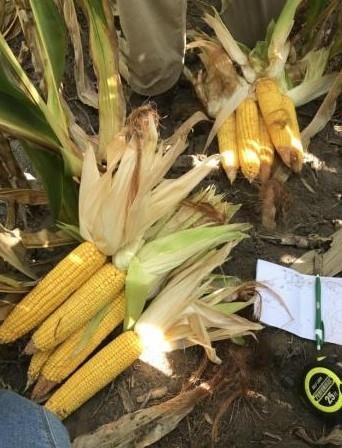By Meaghan Anderson
Anytime after R3 (milk stage) has traditionally been a great time to do yield checks in corn. After R3, kernel abortion is less likely and plant stress will result in reduced kernel size or fill rather than kernel loss. In addition to performing a yield check, walking late reproductive corn provides a good opportunity to check the field for other things like stalk rots or other standability issues and foliar disease, especially if you left any test strips of untreated vs. fungicide-treated areas of fields. My colleague Patrick Hatting, Farm Management Specialist for central Iowa, and I performed yield checks in several Polk County corn fields in mid-August. See the details below.

Patrick and I visited 9 corn fields in Polk County on August 18 to do yield estimates. In each field, we arbitrarily chose a location sufficiently far from the field edge or any confounding areas (waterways, demonstration plots, etc.). While other methods exist, the most common method of making yield estimates is the traditional “yield component method.” If you’re interested in the full details on estimating yield using this method, check out this ICM Encyclopedia article on the topic.
Steps to estimating yield using the “yield component method”:
- Measure 1/1000th of an acre and count number of plants with harvestable ears. In 30-inch row corn, 1/1000th of an acre is 17 feet, 5 inches.
- Choose several ears in the 1/1000th of an acre to count kernels on. We chose 6 per measurement and selected them by choosing every 5th harvestable ear. You can choose any method, but we suggest using a method to remove some subjectivity from selection and try to reduce the chances of biasing your sample.
- Count the number of kernel rows around each ear and determine the average number of kernel rows around.
- Count the approximate number of harvestable kernels on the length of each ear and determine the average kernels per row.
- Use the following math equation to determine an approximate yield for the field based on your sample:

Collecting more ears per sample and more samples from an individual field should lead to a more accurate representation of yield. A more thorough yield estimation might use 10 ears per sample and collect samples from 5 different areas of the field.
One hotly debated topic is the appropriate denominator number to use for the kernels per bushel in the yield component equation. 90,000 has always been a standard used in this equation, but more updated sources suggest that modern hybrids may have fewer kernels per bushel. The key factor is that this number is simply assumed and is likely to be variable based on corn hybrid and environmental conditions during grain fill. In years with significant stress during grain fill, kernels are likely to be smaller and that denominator of kernels per bushel may need to be higher – perhaps 100-120,000 kernels per bushel. In other years, the number could be lower than 90,000. This can be especially challenging when trying to determine a yield estimation but is an important note since so much of yield depends on kernel size and kernel fill during the later reproductive stages.
Remember that yield estimates are just that – estimates. The average yield of our 9 estimates using this method was 217 bu/ac in Polk County, but I’ll be very pleasantly surprised if the average corn yield approaches that number! Be sure to note areas where yield estimates are made in order to make comparisons after combines have run; you may even be able to approximate the number of kernels per bushel and see how close you were to the correct number (for this year, and this hybrid).
Source : iastate.edu